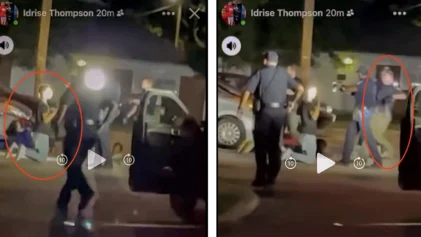The family of an Ohio man who died while sleeping at the hands of a police officer, is set to receive $4.4 million. After proving their claim in civil court, a jury has ordered the cop that fatally shot a Black motorist to pay his relatives compensation for his premature death.
On Tuesday, Nov. 1, the verdict for the wrongful death of 23-year-old Luke Stewart initiated by his estate against Euclid Police Sgt. Matthew Rhodes was rendered. Four years after his 2017 death, Mary Stewart, Luke Stewart’s mother, refiled a wrongful death lawsuit against Rhodes.
The case was tried in front of Judge Shannon M. Gallagher at the Cuyahoga County Court of Common Plea, who supported a jury’s decision to require Rhodes to pay the relatives a multi-million award, while still declining to have them compensate them for any punitive damages or attorney’s fees, Cleveland-area newspaper The News-Herald reports.
In a statement from the city of Euclid, officials stated they were disappointed in the trial’s outcome.
“The city of Euclid and Euclid Police Department are aware of the decision made in the civil trial regarding Euclid Police Sergeant Matthew Rhodes,” the remark read. “While we respect the judicial process, we are disappointed in the outcome of this trial and are currently evaluating our next course of action in this matter.”
During the trial, it was revealed a woman called law enforcement after seeing Stewart’s black Honda outside on her home South Lake Shore Boulevard in Euclid, Ohio, in March 2017 with its parking lights on. She reported a “suspicious car” with dark windows was stopped in front of her house for about 20 minutes, and officers responded to her angst.
According to court documents, after arrival, the officers assessed there was a man in the car and believed him to be under the influence.
Officer Louis Catalani, who was the first to arrive on the scene, found Stewart sleeping in the vehicle. He beamed his flashlight in Stewart’s face, but the driver did not respond. While looking inside of the car window, the officer said he saw a digital scale in the center console and what appeared to be a half-burnt blunt on the passenger seat. In addition to the marijuana cigar, the cop also said he thought he saw a wine bottle cap on the floor of the car near the driver’s feet.
The officer retrieved the information from his license plate and back to his car to run them, discovering the car was registered to a man who seemed way older than the man he saw sleep. In addition to the age discrepancy, there was an issue because the owner of the car had an active arrest warrant, and Catalani could not confirm the person in the car was not the same person.
Catalani heard that another officer, Rhodes, was on his way, and resolved once his support arrived, they would remove the man from the car.
The trial determined when the officers approached Stewart’s car, Catalani came alongside the driver’s side and Steward approached the passenger side. Catalani knocked on the window again. This time he waved and said “hi,” without announcing himself as a police officer to the young man.
According to the officer, this time the young man responded to him, waving back.
Stewart sat himself up and started his car up.
Catalani attempted to stop him saying, “No. No. No. Stop. Stop. Stop,” and grabbed the driver’s side door handle.
The officer then attempted to pull Stewart out of the car, while Rhodes, from the other side, was trying to push him out. At this point, court records state, Stewart put his vehicle gear in drive and started moving, court documents state.
Somewhere in this sequence of events Rhodes climbed into Stewart’s car, prompting a struggle between the two men. During the tussle, Rhodes tased an unarmed Stewart, struck him, and then fatally shot him four times.
Neither police officer activated his dashboard camera or belt microphone, which according to experts who testified in the case neglected the best practices usually adhered to by the department.
In the state of Ohio, police dashcam footage is considered a public record and is a tool to also hold police accountable. Stewart’s mother’s attorney Sarah Gelsomino said because lack of dashcam footage in the trial “deprived the public of a key piece of evidence.”
Originally, in July 2018, U.S. District Judge James S. Gwin dismissed the lawsuit. The judge believed the case was a “close and difficult question,” because there was probable cause for the officer to believe he was in danger of serious physical harm.
The lawsuit was refiled in 2021 and prevailed the last time, resulting in the aforementioned award.
Rhodes was elevated to the office of sergeant in January 2022, despite the civil lawsuit pending at the time.


